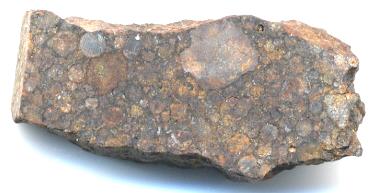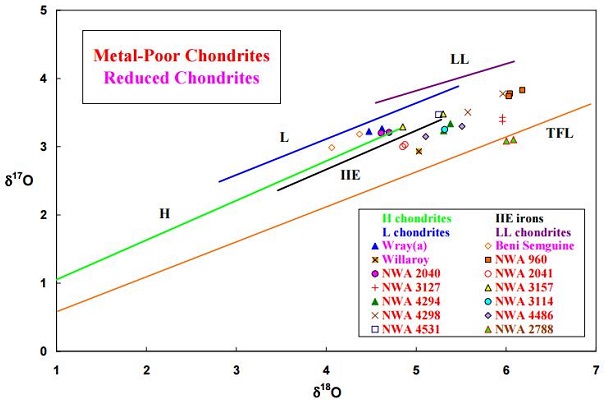LL3.10, metal-poor
(possible ungroupedModifying term used to describe meteorites that are mineralogically and/or chemically unique and defy classification into the group or sub-group they most closely resemble. Some examples include Ungrouped Achondrite (achondrite-ung), Ungrouped Chondrite (chondrite-ung), Ungrouped Iron (iron-ung), and Ungrouped Carbonaceous (C-ung). Click on Term to Read More ordinary chondriteWork in Progress Ordinary chondrites (OCs) are the largest meteorite clan, comprising approximately 87% of the global collection and 78% of all falls (Meteoritical Society database 2018)1. Meteorites & the Early Solar System: page 581 section 6.1 OC of type 5 or 6 with an apparent shock stage of S1, Click on Term to Read More)

Purchased October 2002
no coordinates recorded A single stone weighing 487 g was found in the Sahara Desert and sold to A. and G. Hupé in Safsaf, Morocco in October 2002. This meteoriteWork in progress. A solid natural object reaching a planet’s surface from interplanetary space. Solid portion of a meteoroid that survives its fall to Earth, or some other body. Meteorites are classified as stony meteorites, iron meteorites, and stony-iron meteorites. These groups are further divided according to their mineralogy and Click on Term to Read More is very weakly shocked to stage S2 and heavily weathered to grade W3. Through analyses conducted at Northern Arizona University (T. Bunch and J. Wittke) and the U.S. Geological Survey in Reston, Virginia (J. Grossman), it was determined that NWA 3127 is a polymict chondriteChondrites are the most common meteorites accounting for ~84% of falls. Chondrites are comprised mostly of Fe- and Mg-bearing silicate minerals (found in both chondrules and fine grained matrix), reduced Fe/Ni metal (found in various states like large blebs, small grains and/or even chondrule rims), and various refractory inclusions (such Click on Term to Read More consisting of an LL3.1 host with LL4 and LL5 xenoliths.
Studies of the compositional, textural, and other petrographic features of
chondrulesRoughly spherical aggregate of coarse crystals formed from the rapid cooling and solidification of a melt at ~1400 ° C. Large numbers of chondrules are found in all chondrites except for the CI group of carbonaceous chondrites. Chondrules are typically 0.5-2 mm in diameter and are usually composed of olivine Click on Term to Read More in NWA 3127 revealed that it had close similarities to those of the LL3.0 Semarkona and the LL3.1 NWA 1756
chondritesChondrites are the most common meteorites accounting for ~84% of falls. Chondrites are comprised mostly of Fe- and Mg-bearing silicate minerals (found in both chondrules and fine grained matrix), reduced Fe/Ni metal (found in various states like large blebs, small grains and/or even chondrule rims), and various refractory inclusions (such Click on Term to Read More. As a sensitive indicator of petrologic subtype (Grossman, 2004; Grossman and Bearley, 2005), the
olivineGroup of silicate minerals, (Mg,Fe)2SiO4, with the compositional endpoints of forsterite (Mg2SiO4) and fayalite (Fe2SiO4). Olivine is commonly found in all chondrites within both the matrix and chondrules, achondrites including most primitive achondrites and some evolved achondrites, in pallasites as large yellow-green crystals (brown when terrestrialized), in the silicate portion Click on Term to Read More chromiteBrownish-black oxide of chromium and iron (Cr-Fe oxide), Cr2FeO4, found in many meteorite groups. Click on Term to Read More contents of NWA 3127 were measured and found to have values (ave. 0.38 wt%) consistent with an LL3.10 classification. After further analyses conducted by Grossman and Brearley (2007), a reclassification was made for NWA 3127 providing a refined subtype of LL3.10. Northwest Africa 3127 has a very low
metalElement that readily forms cations and has metallic bonds; sometimes said to be similar to a cation in a cloud of electrons. The metals are one of the three groups of elements as distinguished by their ionization and bonding properties, along with the metalloids and nonmetals. A diagonal line drawn Click on Term to Read More abundance, which was found to be a primary feature rather than an effect of terrestrial weathering.
After the publication of NWA 3127 in MetBull 89 as an LL3.1 chondrite, Rumble III
et al. (2007) conducted a survey of the O-isotopic composition of this meteorite and several other metal-poor, ungrouped chondrites in the NWA-series: 960 [ung], 2040 [LL], 2041 [L], 3114 [L], 3127 [LL], 3157 [L], 4294 [LL], 4298 [LL], 4486 [L], and 4531 [LL]. It is demonstrated in the
oxygenElement that makes up 20.95 vol. % of the Earth's atmosphere at ground level, 89 wt. % of seawater and 46.6 wt. % (94 vol. %) of Earth's crust. It appears to be the third most abundant element in the universe (after H and He), but has an abundance only Click on Term to Read More three-isotope diagram below that these meteorites plot far away from the trend lines for the H, L, and LL ordinary chondrite groups, and they probably represent several previously unrecognized parent asteroids (Irving
et al., 2014,
#5332). See further details about this ‘supra-TFL’ grouping of meteorites on the
HaH 180 page.

Diagram credit: Rumble III
et al., 38th LPSC,
#2230 (2007) Additionally, the ungrouped chondrites NWA 4486 and NWA 5717, as well as the ungrouped achondrites NWA 7835 (Irving
et al., 2014,
#5332) and NWA 10769 (Moggi Cecchi
et al., 2016,
#2696), might be related to this metal-poor group of meteorites. The specimen of NWA 3127 shown above is a 1.1 g partial slice.








